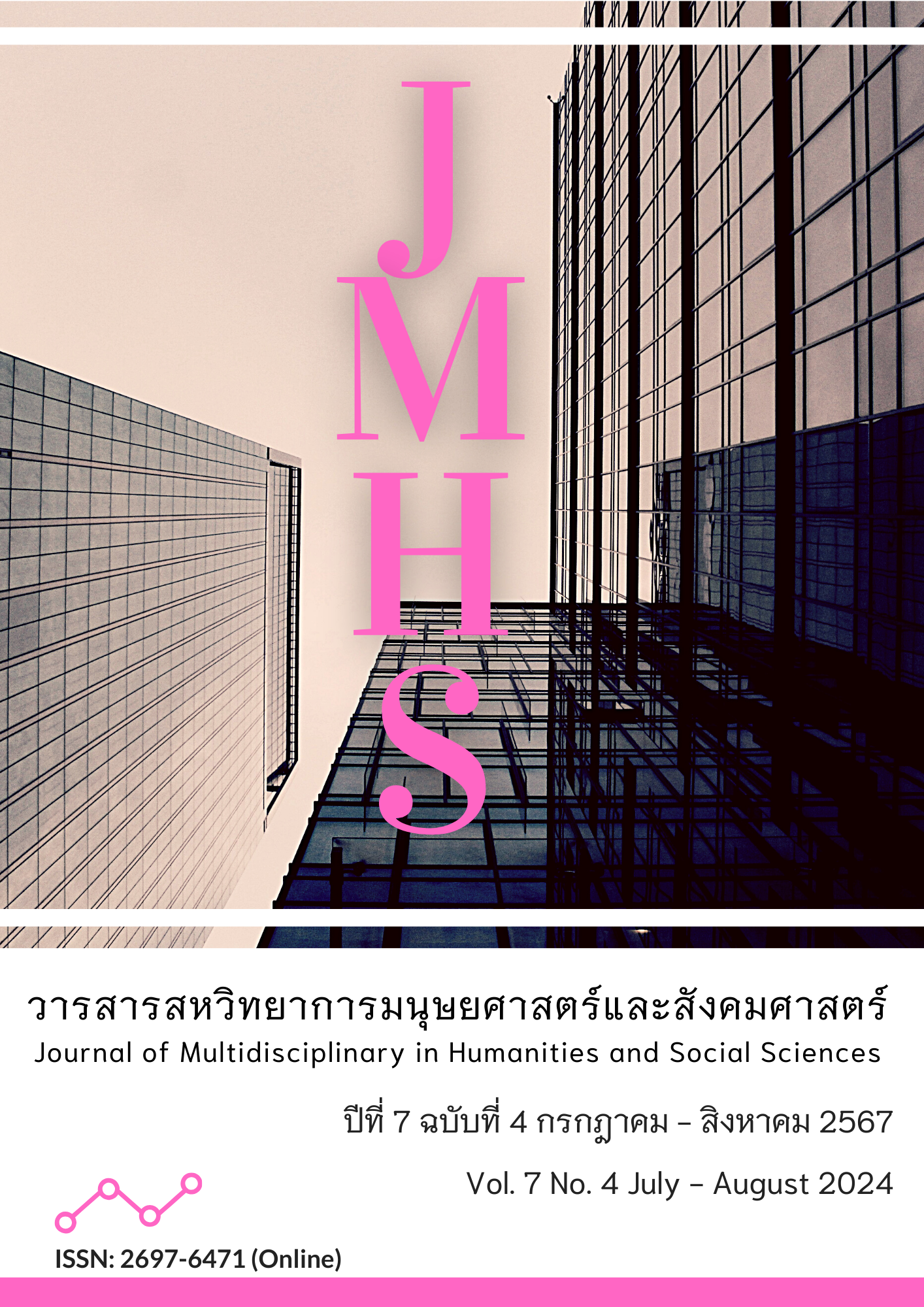Causal Factors Influencing Loyalty in Get Service in Applied Thai Traditional Medicine via Facebook Page in Bangkok and Its Vicinity
Main Article Content
Abstract
The article aimed to 1) develop and validate a causal relationship model of loyalty in getting service in applied Thai traditional medicine via a Facebook page in Bangkok and its vicinity; and 2) study causal factors of loyalty in getting service in applied Thai traditional medicine via a Facebook page in Bangkok and its vicinity. This study was quantitative research. The sample consisted of people who have gotten service in applied Thai traditional medicine via their Facebook page and live in Bangkok and its vicinity of 220 people. The research was conducted using online questionnaires. The statistics used in data analysis were frequency, percentage, confirmatory factor analysis, and structural equation model. The results of this research were the development of the causal relationship models, which consisted of four components: 1) service quality perception; 2) relationship quality; 3) satisfaction; and 4) loyalty. The model was consistent with the empirical data to a significant extent. The statistics showed that CMIN/df = 1.84, GFI = 0.94, AGFI = 0.90, SRMR = 0.03, and RMSEA = 0.06. The final predictive coefficient was 0.71, indicating that the variables in the model can explain the variance of the loyalty to get service in applied Thai traditional medicine via Facebook page by 71 percent. It was found that relationship quality, satisfaction, and service quality perception were respectively influenced by loyalty to the service. Entrepreneurs who run the business of an applied Thai traditional medicine clinic should consider relationship quality and satisfaction as important in order to create loyalty by returning to get service at the clinic.
Article Details

This work is licensed under a Creative Commons Attribution-NonCommercial-NoDerivatives 4.0 International License.
Views and opinions appearing in the Journal it is the responsibility of the author of the article, and does not constitute the view and responsibility of the editorial team.
References
คณะแพทย์ศาสตร์ โรงพยาบาลรามาธิบดี. (2561). การแพทย์แผนไทยประยุกต์ (Applied Thai Traditional Medicine). สืบค้นเมื่อ 7 มกราคม 2567, จาก https://www.rama.mahidol.ac.th/altern_med/th/thai_traditional_medicine
จุฑารัตน์ เหล่าพราหมณ์. (2561). ปัจจัยเชิงสาเหตุระหว่างการรับรู้คุณภาพการบริการ ความพึงพอใจและความจงรักภักดีของผู้โดยสารสายการบินต้นทุนต่ำ ในประเทศไทย. วารสารวิชาการการท่องเที่ยวไทยนานาชาติ, 14(2), 124-154. สืบค้นจาก https://so02.tci-thaijo.org/index.php/jitt/article/view/175405/125872
ฐาณุพัชช์ จิตภักดีภรรัชต์. (2564). ผลกระทบของอัตลักษณ์อาหารริมทางที่ส่งผลต่อความตั้งใจซื้อความพึงพอใจ และการบอกต่อของลูกค้ากลุ่มเจเนอเรชั่นซี. วารสารเครือข่ายส่งเสริมการวิจัยทางมนุษยศาสตร์และสังคมศาสตร์, 4(1), 14-28. สืบค้นจาก https://so06.tci-thaijo.org/index.php/hsrnj/article/view/252047
ณมน อังคะหิรัญ และ อมรินทร์ เทวตา. (2566). ปัจจัยที่ส่งผลต่อความจงรักภักดีของลูกค้าผ่านความพึงพอใจของลูกค้าของร้านส่งสินค้าเบ็ดเตล็ด. The New Viridian Journal of Arts, Humanities and Social Sciences, 3(2), 1-16. สืบค้นจาก https://so01.tci-thaijo.org/index.php/The_New_Viridian/article/view/262441/173423
นันทนาฏ อุพงค์, บุญฑวรรณ วิงวอน และ พิชาภพ พันธุ์แพ (2564). การจัดการลูกค้าสัมพันธ์ทางอิเล็กทรอนิกส์ที่ส่งผลต่อความภักดีผ่านบทบาทเชื่อมโยงของคุณภาพความสัมพันธ์และประสบการณ์ลูกค้าในธุรกิจธนาคารพาณิชย์. วารสารวิชาการบริหารธุรกิจ: สมาคมสถาบันอุดมศึกษาแห่งประเทศไทย มหาวิทยาลัยวงษ์ชวลิตกุล, 10(1), 123-141. สืบค้นจาก https://so02.tci-thaijo.org/index.php/apheitvu/article/view/247388
ประสิทธิชัย นรากรณ. (2561). คุณภาพความสัมพันธ์และแรงสนับสนุนทางสังคมในฐานะตัวแปรเชื่อมโยงระหว่างโซเชียลคอมเมิร์ซกับความตั้งใจซื้ออย่างต่อเนื่อง. วารสารวิทยาการจัดการ มหาวิทยาลัยราชภัฏเชียงราย, 13(1), 44–69. สืบค้นจาก https://so03.tci-thaijo.org/index.php/jmscrru/article/view/128070/96365
ประอรพิต กัษฐวัฒนา. (2564). เจาะลึกความต้องการ ‘บุคลากรแพทย์แผนไทย’ รับตลาดสมุนไพรโตในยุควิกฤตโรคระบาด. สืบค้นเมื่อ 24 มีนาคม 2567, จาก https://www.salika.co/2021/10/16/thai-traditional-medicine-wanted-for-herbal-marketing/
พนัชกร สิมะขอรบุญ และ ตติยา คู่มงคลชัย. (2561). ปัจจัยเหตุของความพึงพอใจที่มีต่อความภักดีของลูกค้า: กรณีเว็บไซต์บิวตี้คูล. Veridian E-Journal, มหาวิทยาลัยศิลปากร, 11(3), 3121-3139. สืบค้นจาก https://he02.tci-thaijo.org/index.php/Veridian-E-Journal/article/view/166069
รังสิมา บุญมา และ อมรินทร เทวตา. (2566). ความภักดีของลูกค้าผักปลอดสารพิษในตลาดเกษตรชุมชนสหกรณ์การเกษตรบ้านลาดจำกัด. The New Viridian Journal of Arts, Humanities and Social Sciences, 3(1), 1-15. สืบค้นจาก http://ithesis-ir.su.ac.th/dspace/handle/123456789/4227
วันดี ทักษะ. (2561). ไขข้อสงสัยสำหรับมือใหม่ เฟซบุ๊กส่วนตัว กับ เพจ ต่างกันหรือไม่. สืบค้นเมื่อ 7 มกราคม 2567, จาก https://www.takraonlinetraining.com/blog/
วิลาสินี จงกลพืช และ มนัสสินี บุญมีศรีสง่า. (2563). คุณภาพการให้บริการในมุมมองของผู้บริโภคที่มีต่อธุรกิจเครื่องแก้ววิทยาศาสตร์กรณีศึกษาบริษัท เอ็น เค
แลบอราทอรี (ประเทศไทย) จำกัด. วารสารการบริหารนิติบุคคลและนวัตกรรมท้องถิ่น, 7(6), 179-189. สืบค้นจาก http://ithesis-ir.su.ac.th/dspace/handle/123456789/3076
วสุธิดา นุริตมนต์. (2564). การรับรู้คุณภาพผลิตภัณฑ์และคุณภาพการบริการที่มีอิทธิพลต่อการใช้บริการซ้ำร้านอาหารญี่ปุ่น. วารสารวิชาการและวิจัย, 11(3), 11-23. สืบค้นจาก https://so04.tci-thaijo.org/index.php/neuarj/article/view/248823
สลิลาทิพย์ ทิพยไกรศร. (2564). ความสัมพันธ์์เชิงสาเหตุุระหว่างการบริหารประสบการณ์์ของลูกค้าความพึงพอใจของลููกค้าความจงรักภักดีีและการบอกต่อในธุรกิจค้าปลีกออนไลน์. วารสารวิชาการบริหารธุรกิจ, สมาคมสถาบันอุดมศึกษาเอกชนแห่งประเทศไทย ในพระราชูปถัมภ์สมเด็จพระเทพรัตนราชสุดาฯ สยามบรมราชกุมารี, 10(1), 198-213. สืบค้นจาก https://so02.tci-thaijo.org/index.php/apheitvu/article/view/245639
สุภสิทธ์ิ ศรศรี. (2564). มุมมองใหม่ต่อผลของคุณภาพความสัมพันธ์ทางอิเล็กทรอนิกส์ที่มีต่อความภักดีในการซื้อสินค้าออนไลน์ของผู้บริโภคเจเนอเรชั่นแซด. วารสารวิชาการบริหารธุรกิจ, สมาคมสถาบันอุดมศึกษาเอกชนแห่งประเทศไทย ในพระราชูปถัมภ์ สมเด็จพระเทพรัตนราชสุดาฯ สยามบรมราชกุมารี, 10(2), 191-209. สืบค้นจาก https://so02.tci-thaijo.org/index.php/apheitvu/article/view/252728/170543
สำนักงานพัฒนาธุรกรรมทางอิเล็กทรอนิกส์. (2565). รายงานผลการสำรวจพฤติกรรมผู้ใช้อินเทอร์เน็ตในประเทศไทย ปี 2565. สืบค้นเมื่อ 7 มกราคม 2567, จาก https://www.etda.or.th/getattachment/78750426-4a58-4c36-85d3-d1c11c3db1f3/IUB-65-Final.pdf.aspx
อุบลวรรณ บุญบำรุง และ ณักษ์ กุลิสร์ (2565). ชื่อเสียง และความพึงพอใจ ที่ส่งผลต่อความภักดีต่อองค์กร ของนิสิตวิทยาลัยนวัตกรรมสื่อสารสังคม มหาวิทยาลัยศรีนครินทรวิโรฒ. วารสารวิชาการนวัตกรรมสื่อสารสังคม, 10(1), 124-135. สืบค้นจาก https://so06.tci-thaijo.org/index.php/jcosci/article/view/249254
Hair, J. F., Black, W. C., Babin, B. J., & Anderson, R. E. (2010). Multivariate data analysis. (7th ed.). Upper Saddle River, NJ: Prentice Hall.
Hair, J. F., Hult, G. T. M., Ringle, C. M., & Sarstedt, M. (2014). A Primer on Partial Least Squares Structural Equation Modeling (PLS-SEM). California, CA: Sage Publications.
Han, H., Chua, B.-L., Lee, S., & Koo, B. (2021). Quality, emotion, price, and social values in building passenger loyalty: Impact of relationship quality (mediator) and in-flight physical environments (moderator). Journal of Travel & Tourism Marketing, 38(2), 123-138.
Hoelter, J. W. (1983). The effects of role evaluation and commitment on identity salience. Social Psychology Quarterly, 46(2), 140–147. https://doi.org/10.2307/3033850
Hu, L.T., & Bentler, P. M. (1999). Cutoff criteria for fit indexes in covariance structure analysis: Conventional criteria versus new alternatives. Structural Equation Modeling, 6(1), 1-55. https://doi.org/10.1080/10705519909540118
Joreskog, K. G., & Sorbom, D. (1984). Advances in factor analysis and structural equation models, Lanham: Rowman & Littlefield Publishers.
Kline, R. B. (2011). Principles and practices of structural equation modeling. (3rd ed.). New York: The Guilford Press.
Schreiber, J. B., Stage, F. K., King, J., Nora, A., & Barlow, E. A. (2006). Reporting structural equation modeling and confirmatory factor analysis results: A review. The Journal of Educational Research, 99(6), 323-337. https://doi.org/10.3200/JOER.99.6.323-338
Schumacker, R. E., & Lomax, R. G. (2004). A beginner's guide to structural equation modeling. (2nd ed.). Mahwah: Lawrence Erlbaum Associates.
Schumacker, R. E., & Lomax, R. G. (2010). A beginner’s guide to structural equation modeling. (3rd ed.). Routledge.
Segoro, W., & Limakrisna, N. (2020). Model of customer satisfaction and loyality. A lecturer at Gunadarma University. Retrieved from https://www.redalyc.org/journal/279/27963086017/html/
Thompson, B. (2004). Exploratory and confirmatory factor analysis: Understanding concepts and applications. American Psychological Association. https://doi.org/10.1037/10694-000
Ullman, M. T. (2001). The declarative/procedural model of lexicon and grammar. Journal of Psycholinguistic Research, 30(1), 37-69. https://doi.org/10.1023/A:1005204207369


